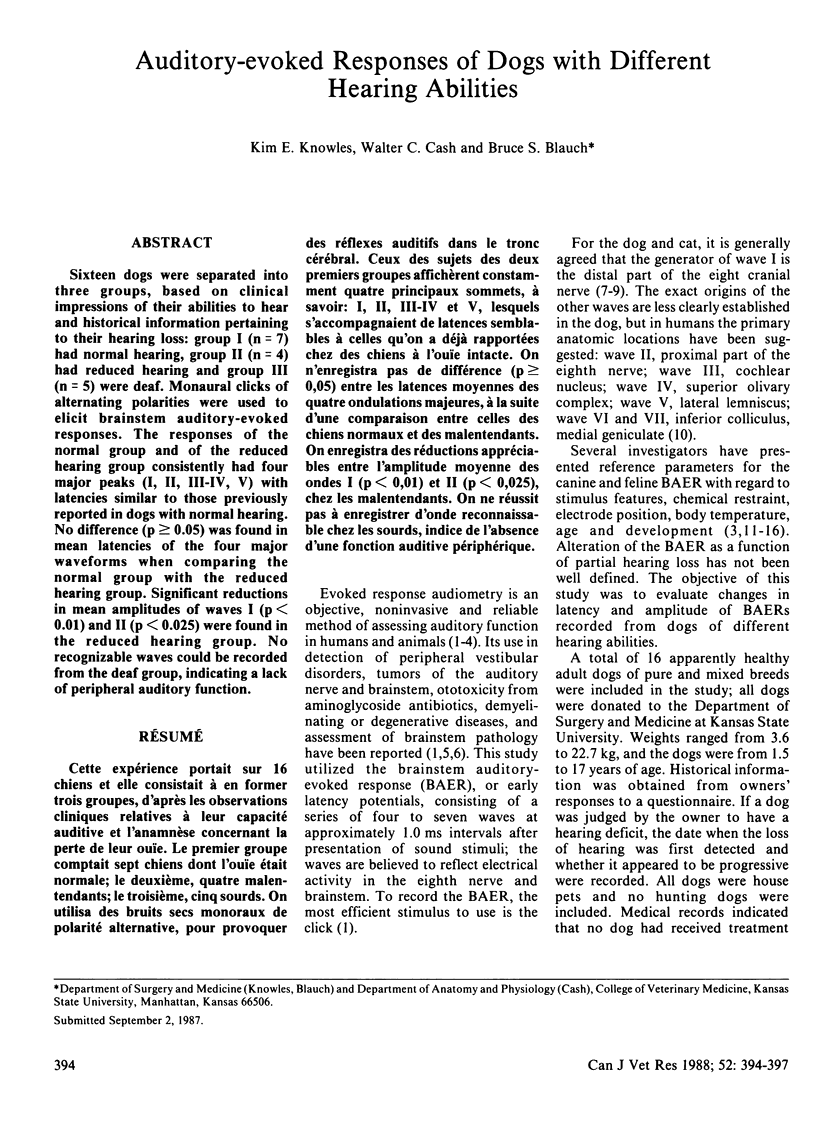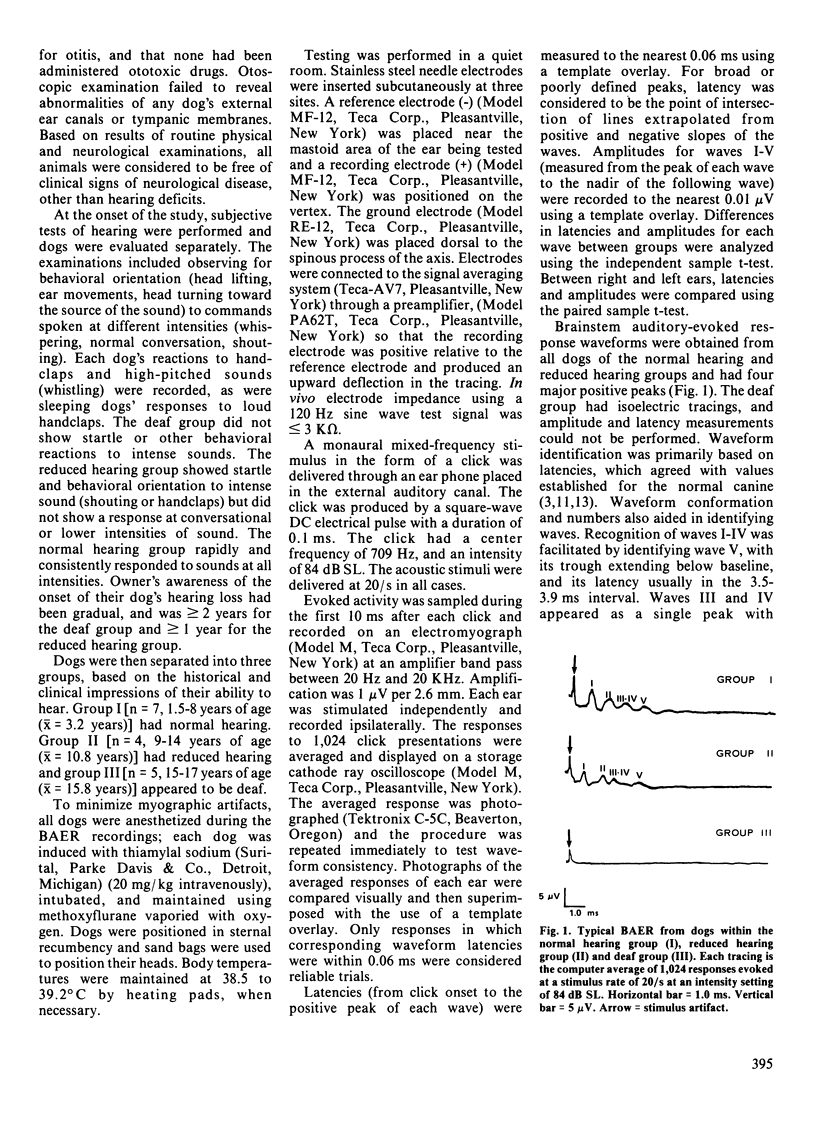Abstract
Sixteen dogs were separated into three groups, based on clinical impressions of their abilities to hear and historical information pertaining to their hearing loss: group I (n = 7) had normal hearing, group II (n = 4) had reduced hearing and group III (n = 5) were deaf. Monaural clicks of alternating polarities were used to elicit brainstem auditory-evoked responses. The responses of the normal group and of the reduced hearing group consistently had four major peaks (I, II, III-IV, V) with latencies similar to those previously reported in dogs with normal hearing. No difference (p greater than or equal to 0.05) was found in mean latencies of the four major waveforms when comparing the normal group with the reduced hearing group. Significant reductions in mean amplitudes of waves I (p less than 0.01) and II (p less than 0.025) were found in the reduced hearing group. No recognizable waves could be recorded from the deaf group, indicating a lack of peripheral auditory function.
Full text
PDF



Selected References
These references are in PubMed. This may not be the complete list of references from this article.
- Achor L. J., Starr A. Auditory brain stem responses in the cat. II. Effects of lesions. Electroencephalogr Clin Neurophysiol. 1980 Feb;48(2):174–190. doi: 10.1016/0013-4694(80)90302-8. [DOI] [PubMed] [Google Scholar]
- Anderson H., Henricson B., Lundquist P. G., Wedenberg E., Wersäll J. Genetic hearing impairment in the Dalmatian dog. An audiometric, genetic and morphologic study in 53 dogs. Acta Otolaryngol. 1968;(Suppl):1–34. [PubMed] [Google Scholar]
- Bodenhamer R. D., Hunter J. F., Luttgen P. J. Brain stem auditory-evoked responses in the dog. Am J Vet Res. 1985 Aug;46(8):1787–1792. [PubMed] [Google Scholar]
- Buchwald J. S., Huang C. Far-field acoustic response: origins in the cat. Science. 1975 Aug 1;189(4200):382–384. doi: 10.1126/science.1145206. [DOI] [PubMed] [Google Scholar]
- Harrison J., Buchwald J. Auditory brainstem responses in the aged cat. Neurobiol Aging. 1982 Fall;3(3):163–171. doi: 10.1016/0197-4580(82)90036-7. [DOI] [PubMed] [Google Scholar]
- Jerger J., Hall J. Effects of age and sex on auditory brainstem response. Arch Otolaryngol. 1980 Jul;106(7):387–391. doi: 10.1001/archotol.1980.00790310011003. [DOI] [PubMed] [Google Scholar]
- Jewett D. L. Volume-conducted potentials in response to auditory stimuli as detected by averaging in the cat. Electroencephalogr Clin Neurophysiol. 1970 Jun;28(6):609–618. doi: 10.1016/0013-4694(70)90203-8. [DOI] [PubMed] [Google Scholar]
- Kay R., Palmer A. C., Taylor P. M. Hearing in the dog as assessed by auditory brainstem evoked potentials. Vet Rec. 1984 Jan 28;114(4):81–84. doi: 10.1136/vr.114.4.81. [DOI] [PubMed] [Google Scholar]
- Marshall A. E. Brain stem auditory-evoked response of the nonanesthetized dog. Am J Vet Res. 1985 Apr;46(4):966–973. [PubMed] [Google Scholar]
- Marshall A. E., Byars T. D., Whitlock R. H., George L. W. Brainstem auditory evoked response in the diagnosis of inner ear injury in the horse. J Am Vet Med Assoc. 1981 Feb 1;178(3):282–286. [PubMed] [Google Scholar]
- Marshall A. E. Use of brain stem auditory-evoked response to evaluate deafness in a group of Dalmatian dogs. J Am Vet Med Assoc. 1986 Apr 1;188(7):718–722. [PubMed] [Google Scholar]
- Morgan J. L., Coulter D. B., Marshall A. E., Goetsch D. D. Effects of neomycin on the waveform of auditory-evoked brain stem potentials in dogs. Am J Vet Res. 1980 Jul;41(7):1077–1081. [PubMed] [Google Scholar]
- Myers L. J., Redding R. W., Wilson S. Reference values of the brainstem auditory evoked response of methoxyflurane anesthetized and unanesthetized dogs. Vet Res Commun. 1985 Sep;9(4):289–294. doi: 10.1007/BF02215152. [DOI] [PubMed] [Google Scholar]
- Shipley C., Buchwald J. S., Norman R., Guthrie D. Brain stem auditory evoked response development in the kitten. Brain Res. 1980 Jan 27;182(2):313–326. doi: 10.1016/0006-8993(80)91191-9. [DOI] [PubMed] [Google Scholar]
- Sims M. H., Moore R. E. Auditory-evoked response in the clinically normal dog: early latency components. Am J Vet Res. 1984 Oct;45(10):2019–2027. [PubMed] [Google Scholar]


